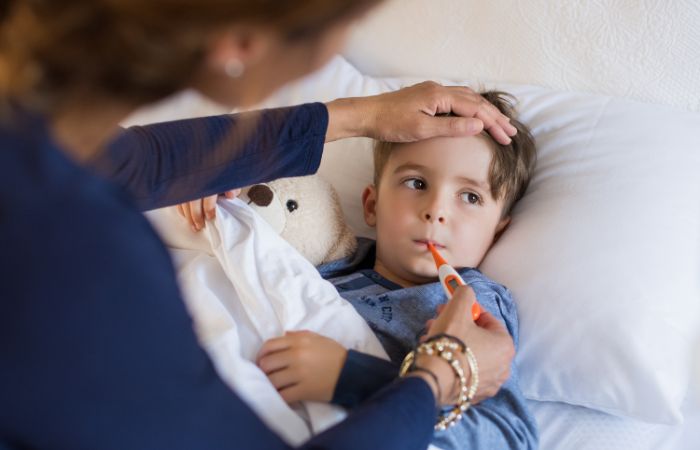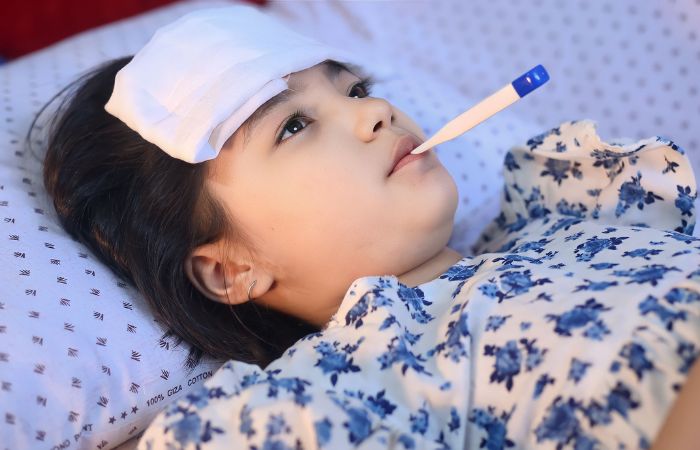
Seasonal changes often bring a host of health challenges for children, with seasonal fevers being a common concern. These fevers can cause discomfort and worry for both kids and their parents. Understanding the causes, symptoms, and effective care tips for managing seasonal fevers can help parents navigate these times more smoothly. In cities like Mumbai, Pune, Nagpur, and Delhi, parents can access reliable diagnostic services through providers like Diagnopein, which offers pathology tests, including fever-related tests and at-home blood collection services.
Seasonal fevers refer to fever episodes that occur more frequently during specific times of the year. These fever in kinds are often linked to changes in temperature, humidity, or the presence of viruses and bacteria that thrive during certain seasons. In tropical countries like India, the transition between the hot summer months to the monsoon and then winter can trigger various seasonal illnesses, which often present with fever as a primary symptom. For children, their developing immune systems make them more susceptible to these seasonal changes.
There are several factors that contribute to seasonal fevers in children. Here are some of the most common causes:
Viral infections are one of the leading causes of seasonal fevers in kids. The monsoon and post-monsoon seasons create the perfect environment for the spread of viruses, such as:
1] Dengue – A mosquito-borne viral infection that often causes fever, rash, and body aches.
2] Influenza – Seasonal flu often occurs in the cooler months and can cause fever, cough, sore throat, and fatigue.
3] Common Cold – A viral infection that thrives in the transition between seasons, causing mild fever along with runny nose, sneezing, and cough.
4] Hand, Foot, and Mouth Disease – This viral infection spreads in the summer months, causing fever and blisters on the hands, feet, and mouth.
These viral infections often spread through respiratory droplets, direct contact, or even contaminated surfaces, making children especially vulnerable as they spend time outdoors or in schools.
Bacterial infections can also lead to seasonal fevers, although these tend to be less common than viral infections. Some examples of bacterial infections that cause fever in kids include:
Typhoid – Caused by the Salmonella bacteria, this infection can lead to high fever, abdominal pain, and weakness.
Pneumonia – Pneumonia caused by bacteria can cause persistent fever, cough, chest pain, and difficulty breathing.
Urinary Tract Infections (UTI) – Bacterial UTIs can cause fever, pain while urinating, and discomfort.
These infections may require more intensive medical treatment, including antibiotics, and prompt diagnosis is essential.

Seasonal changes also bring changes in allergens such as pollen, dust, and mold. Exposure to these allergens can trigger allergic reactions in children, often manifesting as a low-grade fever accompanied by other symptoms like sneezing, watery eyes, or a runny nose. Additionally, changes in humidity and temperature can impact respiratory health, leading to infections and fevers.
In areas where monsoons bring a rise in mosquito activity, diseases like malaria can cause fever in children. Malaria, transmitted by the Anopheles mosquito, is common in tropical areas like parts of Mumbai, Pune, and Delhi. Symptoms of malaria include high fever, chills, fatigue, and body aches.
Seasonal fevers in children often present with a combination of symptoms that vary depending on the underlying cause. Common symptoms to watch for include:
1] Fever: A persistent or recurring rise in body temperature is the primary symptom of seasonal fevers. A temperature above 100.4°F (38°C) is considered a fever.
2] Cough and Sore Throat: Respiratory viral infections like the flu or common cold often come with cough, sore throat, and nasal congestion.
3] Body Aches and Fatigue: Children may experience overall body aches, weakness, and tiredness, especially with viral infections like the flu.
4] Rashes: Some viral infections like dengue or hand, foot, and mouth disease can cause rashes along with fever.
5] Chills and Sweating: Fevers associated with malaria or bacterial infections may come with chills followed by sweating as the body tries to regulate temperature.
6] Loss of Appetite: A reduced appetite and stomach discomfort are common in children with fever, particularly if the cause is gastrointestinal like typhoid or a viral infection.
When your child has a seasonal fever, it's important to manage their symptoms effectively while ensuring they receive the right care. Here are some essential care tips:
Fever can lead to dehydration, so it's crucial to ensure your child drinks plenty of fluids. Offer water, clear soups, fruit juices, or oral rehydration solutions (ORS) to maintain hydration. Avoid sugary drinks or caffeine, as they can make dehydration worse.
If your child is uncomfortable due to fever, you can use fever-reducing medications like acetaminophen (paracetamol) or ibuprofen. Always consult a doctor before giving medications, and follow the prescribed dosage. These medications help lower the fever and relieve associated discomfort like body aches and headaches.
Rest is essential for your child’s recovery. Create a calm and quiet environment to allow your child to sleep and recuperate. Make sure they have comfortable clothing, and adjust the room temperature to prevent overheating.
Keep a close eye on your child’s temperature throughout the day, especially if the fever is persistent. If the fever exceeds 104°F (40°C) or lasts for more than 3 days, seek medical advice immediately. In cities like Mumbai, Pune, Nagpur, and Delhi, reliable pathology labs like Diagnopein offer fever-related tests to determine the underlying cause of the fever.
While mild fevers are common, some symptoms may require urgent medical attention. Seek medical help if your child experiences: Severe headache, Difficulty breathing, Persistent vomiting, Severe abdominal pain, Rashes that do not fade when pressed
In addition to conventional treatments, some parents find relief in natural remedies like:
1] Warm baths: A lukewarm bath can help bring down the body temperature and provide comfort.
2] Herbal teas: Ginger tea or chamomile tea can soothe the throat and reduce fever.
If your child’s fever persists, it may be necessary to get a pathology test to determine the underlying cause. In Pune, Mumbai, Delhi, and Nagpur pathology labs like Diagnopein offer comprehensive fever-related tests, including blood tests, malaria tests, and viral panels. Early diagnosis can help start the right treatment promptly.
If your child’s fever is accompanied by severe symptoms or doesn’t improve with basic care measures, consult a doctor immediately. A healthcare provider can recommend a pathology test near me to assess the cause of the fever and suggest appropriate treatment. Some fevers may require antibiotics if a bacterial infection is detected, while others may require antiviral medications or other supportive care.
Seasonal fevers are common in children, but with proper care and attention, they can be managed effectively. Monitoring symptoms, keeping your child hydrated, ensuring rest, and using fever-reducing medications can help alleviate discomfort. Additionally, timely diagnostic tests like hemoglobin tests or fever-related blood tests are crucial in identifying the root cause of the fever. Providers like Diagnopein offer at-home blood collection services in Mumbai, Pune, Nagpur, and Delhi, making it easy for parents to ensure their child receives the right diagnosis and care. Always consult a healthcare professional if you’re concerned about your child’s health or if the fever persists.